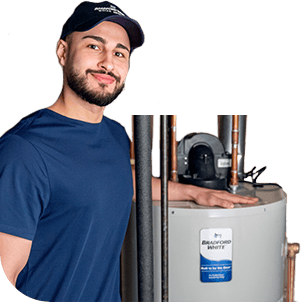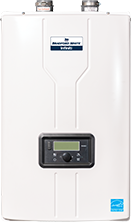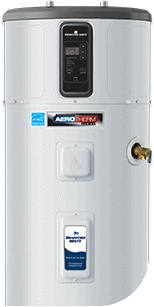8 Things to Consider When Choosing a Water Heater for Your Home

When it comes to keeping your home comfortable, the right water heater can make a big difference. Here are eight key considerations you should mull over before investing in your next water heater:
1. The Right Size Tank
Ensure you get the tank size just right for your household needs. A water heater’s tank capacity is crucial; too small and you’ll be in for a cold shower when demand surpasses the supply. On the other hand, a tank that’s too large can lead to unnecessary energy expenditure. It is generally recommended to have a water heater that holds about 10-15 gallons per occupant on average.
A licensed plumber or HVAC professional can help make sure you get the right size water heater for your home. Need to find a plumbing professional near you? Search here to find a Bradford White professional in your area.
2. Fuel Type and Availability
Choosing a fuel type makes a big difference in terms of the unit’s efficiency and the cost of operation. Electric water heaters are generally less expensive to purchase and install, but they are costlier to operate. Electric water heaters have no greenhouse gas emissions, making them an eco-friendly choice. Natural gas water heaters are affordable and offer strong performance. If you’re considering tankless water heaters, know that they often require gas lines or stronger electrical systems.
3. Energy Efficiency
Water heating accounts for a significant portion of your energy bill. Opt for a high-efficiency model as it will save you money in the long run, especially if you can find one that qualifies for rebates and incentives. You can search here for available rebates and tax credits in your area. Look for the water heater’s Uniform Energy Factor (UEF) rating to gauge a water heater’s efficiency; a higher number indicates a more efficient system. Learn more about your water heater’s UEF rating here.
4. Upfront and Operating Costs
Your initial investment is not the only cost to consider. Operating costs will play a significant role in your long-term budgeting. Evaluate the life-cycle cost of the system, considering the purchase price, installation costs, and your estimated annual energy expenses. For example, tankless water heaters are more costly upfront but can be more affordable in the long term due to their energy efficiency and longer lifespan. Similarly a heat pump water heater has a higher up-front cost but can save you hundreds of dollars a year in energy costs-effectively paying for itself over time.
5. Longevity and Durability
Investing in a water heater that will stand the test of time is crucial. While you may be tempted by a less expensive water heater, a quality water heater will provide you with many years of strong performance and trouble-free operation. Consider a water heater with features that reduce corrosion and built-up mineral scale, such as a glass-lined tank or fiberglass insulation. For example, Bradford White water heaters feature Vitraglas® Tank Lining with Microban®, which helps prevent the growth of bacteria, mold, and mildew on the surface of the tank lining, while Bradford White’s Hydrojet® Total Performance System helps reduce sediment to maximize the life and performance of your water heater.
6. Recovery Rate
The recovery rate, measured in gallons per hour (GPH), indicates how quickly a water heater can reheat a full tank of water after it has been depleted. This is particularly important if you have a large family or if your peak water usage times coincide with those of your household members. A higher recovery rate can ensure that you never run out of hot water, even during times of high demand. Plumbing professionals use the recovery rate among other factors to help determine the right water heater for your home’s needs.
7. Size and Space Constraints
Check the dimensions of your space and match them with the physical size of your desired water heater. Don’t forget to leave sufficient room for maintenance and potential repairs. Incoming and outgoing water lines must match the heater’s specifications, as well as any ventilation requirements for gas models. If space is tight, smaller water heaters are available, like Bradford White’s Lowboy Electric Water Heater. To save space, tankless water heaters are often mounted on a wall.
8. User-Friendly Features
Many water heaters offer a variety of convenient features. Adjustable thermostats and vacation modes can give you more control over your water heater than ever before. Look for safety features as well, such as Bradford White’s Defender Safety System that uses Flammable Vapor Ignition Resistant technology with ScreenLok® to prevent possible ignited vapors from traveling outside of your gas water heater.
Remember, your water heater is an investment that you’ll live with for years, so consider these features carefully. Making a well-informed decision now can lead to a more comfortable home and a better bottom line for years to come.
Microban® antimicrobial product protection helps prevent the growth of bacteria, mold and mildew that may affect the product. The built-in antimicrobial properties do not protect users or others from disease-causing organisms. Microban® is a registered trademark of Microban Products Company.



